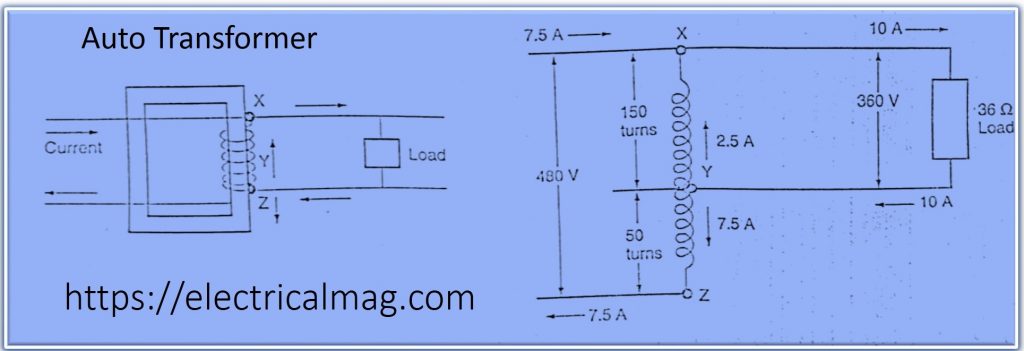Autotransformer Introduction
The prefix auto means self. An autotransformer is a self-induced transformer. It has the primary and secondary windings electrically connected. When the transformer is used as a step-down transformer, the entire winding serves as the primary winding. The section XY is common to both the primary and secondary windings.
As with the two-winding transformer, the ratio of potential differences equals the ratio of primary turns to secondary turns.
EH / EX = TH / TX
For example, the autotransformer has a total of 200 turns. Section has 150 turns and section has 50 turns. A potential difference of is applied across the transformer winding. The potential difference is therefore between and, and 120 V between and .
EH / EX = TH / TX
360/120 = 150/50
Autotransformer Efficiency
An autotransformer is more efficient than a similar two-winding transformer, because the section common to the primary and secondary carries the difference between the primary and secondary current. This reduction in current makes the copper loss in an autotransformer much less than the copper loss in a two-winding transformer.
For example, suppose a resistive load of 36 Ω is connected to terminals X and Y. According to Ohm’s law, the current in the load will be 10 A.

I = E/R
I = 360 V/ 36 Ω
I = 10 A
Therefore, the power output is 3600 W
Pout = E x I
= 360 V × 10 A
=3600 W
The power input equals the power output, so the primary current is 7.5 A.
Pout = E x I
I = Pout / E
I = 3600 W / 480 V
= 7.5 A
If you now apply Kirchhoff’s point rule to point, you can see that the current in section of the winding is only 2.5 A. The diagram shows the currents in each path connected to point .
Autotransformers are used in boosting the potential difference across a distribution line by small fraction to compensate for voltage drop in the line. Another common use of the autotransformer is in starting large ac motors. The potential difference is reduced at starting, and held at that level until the motor reaches about 75% of its rated speed. Then, the motor is switched over to full potential difference across the line.
Autotransformer can be dangerous if used for reducing a high potential difference. If the winding that is common to both the primary and secondary should become open, the full potential difference across the primary terminals will occur across the secondary terminals.

3 thoughts on “Autotransformer Application and Construction”
Comments are closed.